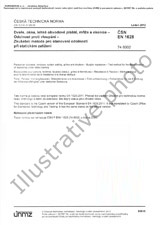We need your consent to use the individual data so that you can see information about your interests, among other things. Click "OK" to give your consent.
ČSN EN ISO 22675 (844020)
Prosthetics - Testing of ankle-foot devices and foot units - Requirements and test methods
Translate name
STANDARD published on 1.1.2017
The information about the standard:
Designation standards: ČSN EN ISO 22675
Classification mark: 844020
Catalog number: 501012
Publication date standards: 1.1.2017
SKU: NS-672473
The number of pages: 108
Approximate weight : 355 g (0.78 lbs)
Country: Czech technical standard
Category: Technical standards ČSN
The category - similar standards:
Implants for surgery, prosthetics and orthoticsAids and adaptation for moving
Annotation of standard text ČSN EN ISO 22675 (844020):
IMPORTANT - This International Standard is suitable for the assessment of the conformity of prosthetic ankle-foot devices and foot units with the strength requirements specified in 4.4 of ISO 22523:2006 (see NOTE 1). Prosthetic ankle-foot devices and foot units on the market, which have demonstrated their compliance with the strength requirements specified in 4.4 of ISO 22523:2006 through submission to the relevant tests of ISO 10328:2006, need not be retested to this International Standard.
WARNING - This International Standard is not suitable to serve as a guide for the selection of a specific ankle-foot device or foot unit in the prescription of an individual lower limb prosthesis! Any disregard of this warning can result in a safety risk for amputees.
This International Standard primarily specifies a cyclic test procedure for ankle-foot devices and foot units of external lower limb prostheses, distinguished by the potential to realistically simulate those loading conditions of the complete stance phase of walking from heel strike to toe-off that are relevant to the verification of performance requirements such as strength, durability and service life.
This potential is of particular importance for the assessment of the performance of a variety of recent designs of ankle-foot devices and foot units with specific characteristics that will only develop under realistic conditions of loading.
In addition, this International Standard specifies a static test procedure for prosthetic ankle-foot devices and foot units, consisting of a static proof test and a static ultimate strength test, distinguished, besides other features, (see NOTE 2) by the potential to generate heel and forefoot forces at lines of action conforming to those occurring at the instants of maximum heel and forefoot loading during the cyclic test.
The loading conditions addressed in the third paragraph are characterized by a loading profile determined by the resultant vector of the vertical and horizontal (A-P) ground reaction forces and by a locomotion profile determined by the tibia angle.
The test loading conditions specified in this International Standard are characterized by standardized formats of these loading and locomotion profiles, to be uniformly applied by the cyclic and static test procedures to each sample of ankle-foot device or foot unit submitted for test.
According to the concept of the tests of this International Standard, each sample of ankle-foot device or foot unit submitted for test is, nevertheless, free to develop its individual performance under load.
NOTE 1: The lines of action of the heel and forefoot forces generated by the static test procedure specified in this International Standard approach those determining the sagittal plane loading of the test loading conditions I and II for the principal structural tests specified in ISO 10328:2016, without changing the values of the angles of the heel and forefoot platform(s) for the structural tests on ankle-foot devices and foot units specified in ISO 10328:2016
Preview of the standard ČSN EN ISO 22675 (844020)
We recommend:
Technical standards updating
Do you want to make sure you use only the valid technical standards?
We can offer you a solution which will provide you a monthly overview concerning the updating of standards which you use.
Would you like to know more? Look at this page.




 Cookies
Cookies
